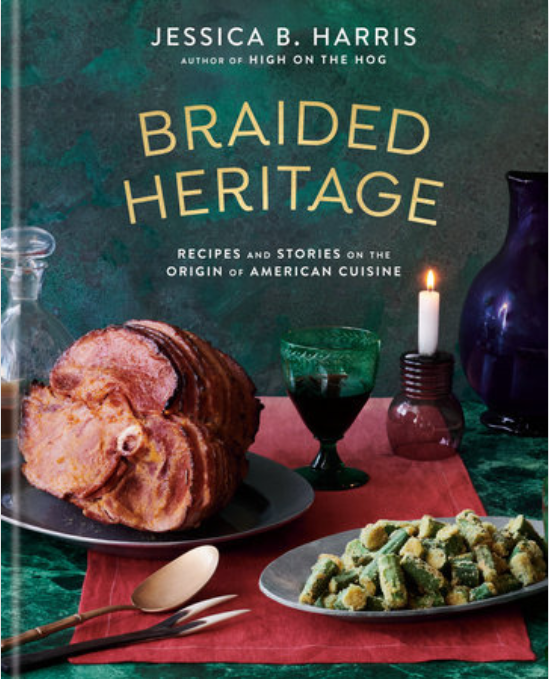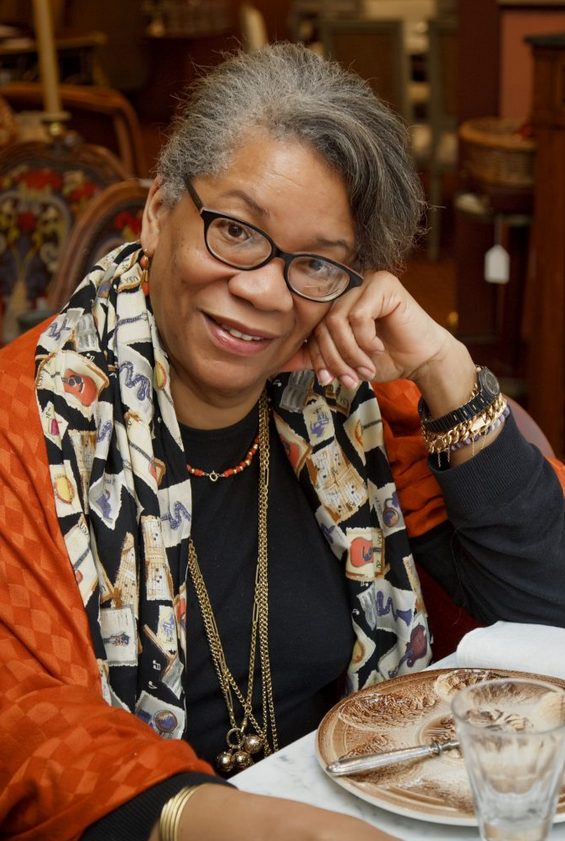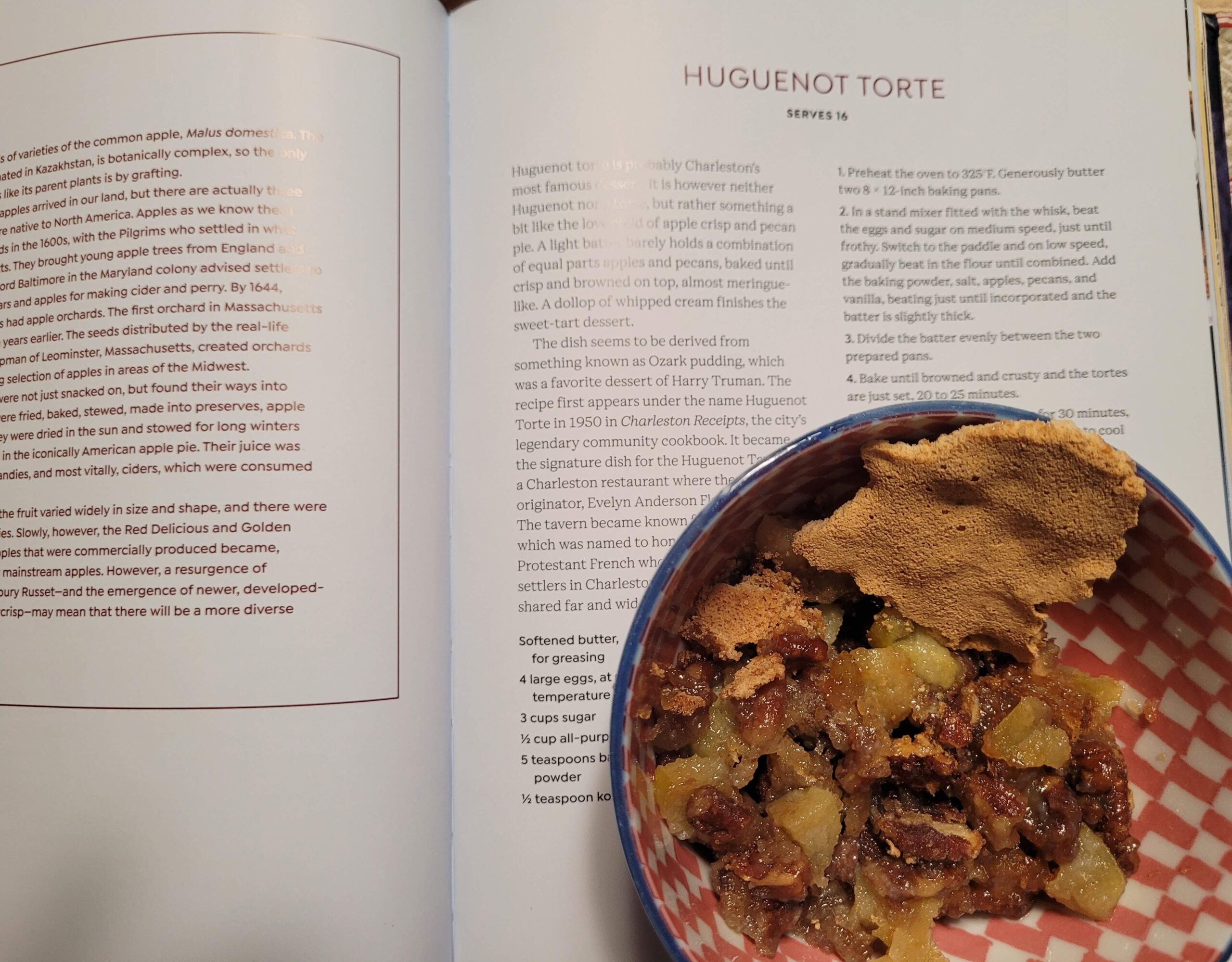I thought for the longest time (as this book set languishing in my TBR stack as the library due date drew closer and closer) that this was a book about bread and baking. I am clueless obviously.
Once I cracked it opened, I was amazed. What an undertaking. Harris braids together a few of the cuisines and cultures that have shaped our tastes and cooking.
About the book:

NATIONAL BESTSELLER • Discover the sweeping story of how Indigenous, European, and African traditions intertwined to form an entirely new cuisine, with over 90 recipes for the modern home cook—from the James Beard Cookbook Hall of Famer and star of the Netflix docuseries High on the Hog.
One of our preeminent culinary historians, Dr. Jessica B. Harris has conducted decades of research throughout the Americas, the Caribbean, and Africa. In this telling of the origins of American food, though, she gets more personal. As heritage is history, she intertwines the larger sweeping past with stories and recipes from friends she’s made over the years—friends from all three threads of the braid, descended from Native peoples, Europeans, and Africans, whose family dishes speak to the crucial era when each thread formed a trinity, and the origins of American food.
Through this mix, we learn that Clear Broth Clam Chowder has both Indigenous and European roots; the same, too, with Enchiladas Suizas, tomatillo-smothered tortillas made “Swiss” with cheese and dairy; and that the hallmarks of African American food through the centuries have been evolution based on region, migration, and innovation, resulting in classics like Red Beans and Rice and Peach Bread Pudding Cupcakes with Bourbon Glaze.
With recipes ranging from everyday meals to festive spreads, Braided Heritage offers a new, in-depth, delicious look at American culinary history. (Taken from Penguin Random House site.)
About the author:

Jessica B. Harris is the author, editor, and translator of seventeen books, including twelve cookbooks documenting the foods and foodways of the African diaspora. Her IACP Award–winning book High on the Hog: A Culinary Journey from Africa to America has been adapted into a Netflix series. Harris is a professor emerita at Queens College/CUNY in New York and has written extensively for scholarly and popular publications. She served as the culinary consultant for the Smithsonian Museum of African American History and Culture and their lauded restaurant, the Sweet Home Café. She holds lifetime achievement awards from the Southern Foodways Alliance, the Soul Summit, and the James Beard Foundation, which also inducted Harris into the Cookbook Hall of Fame. (Taken from Penguin Random House site.)
What I thought…
Like I said, I was not expecting what was inside this book. The history Harris presents, the personalities she highlights and the recipes she chose were so interesting and insightful.
The book is organized into three sections: The Native Peoples, The Europeans, and African Americans. In each section, Harris presents bios and insights on people who have experienced these food cultures OR have been proponents or spokespersons for them. Harris herself writes interesting and informed histories to preface each section.
There is a myriad of traditions in all food cultures, but Harris acknowledges this is especially true of The Native People. I’m glad she started with this often overlooked food tradition which is just now gaining traction and exposure in the foodie world.
Call them Native Americans, Indigenous Peoples, First Peoples, or as does the Smithsonian Museum on the Mall in DC, American Indians. Whatever denomination you wish to use, the fact remains that they were here first: before the Europeans, before the Africans. (16)
Harris grew up in the Northeast so two of the tribes she focuses upon are the Wamponoag and the Shinnecock. Their diets were reliant on lots of seafood and what could be foraged. Did you know that you could eat sugar maple leaves? Beer-Battered Maple Leaves (with Cranberry Syrup) proves it (24).
The Tunica-Biloxi (Yoroniku-Halayihku) tribe is from the Louisiana area and a lot of the recipes here are heavily influenced by the French. The Oglala Lakota section features recipes of the Great Plains.
Throughout The Native People’s section, Harris adds information and history about specific foods that are important to the culture like sugar maple, cranberries, the three sisters (corn, squash and beans), bison and buffalo, corn, and wild rice. Not surprising, these recipes featured very little (if any) refined sugar. Most were hearty, filling recipes. I have earmarked some of the stews for this Fall.
The Europeans section focused on the influences of the Spanish, British, Dutch, and French.
The Spanish section focuses on recipes from the border area of Mexico-Texas. Again, most of these were simple, filling meals like enchiladas, chile con carne, and chile verde. I was tempted by a lot of these recipes.
Charleston is the focus for the British influence but it’s still just pretty dang Southern with okra and oysters. The English influence definitely shows in the lamb roast and the sausage pinwheels. The Huguenot Torte (115) was a new dessert for me. Harris describes it as “a bit like the love child of apple crisp and pecan pie” (115).
The Dutch “braid” features a cabbage dish, Belgian Waffles, tea cookies, doughnuts, and an interesting egg nog like drink (Kandeel).
Of course New Orleans is the focus of The French section. There are two savory dishes but the rest are three different variations of beignets, a rum baba, La Colle (a praline like candy) and Cherry Bounce (a cherry-infused vodka).
The African Americans is the most comprehensive section and focuses on recipes and influences from the Great Migration, different regions, and traditional “Southern” recipes. I literally bookmarked the most recipes from this section:
-
Daddy Robert’s Fricasse Chicken or Pork (155)
-
Turkey—spatchcocked and seasoned with garlic powder, sweet paprika, salt and pepper (156)
-
Leni’s High-Summer Tomato Salad (168)
-
Roasted Golden Beet Salad (189)
-
Brown Sugar Pound Cake (205)
-
Banana fritters (248)
-
Crisp Oatmeal-ish Cookies (251)
Harris ties the entire book together in “Eating the American Braid” along with more of her own history and foodways (208-210). When she describes her mother’s food, she says, “The American braid was on the table nightly” (209). Harris’ own culinary influences are drawn from everywhere and started at her mother’s table and while visiting Northern and Southern family. Harris has traveled extensively and she acknowledges that “the African American traditions of my childhood remained the bedrock of my food memories” (209).
There’s lots of okra recipes in her section along with a lot of desserts. See my list above. The lovely ham recipe on the front cover is one of Harris’ family recipes.
I had to try my hand at that Huguenot Torte (115). The recipe served 16 people so I decided to cut it in half. It would have been a great success but I didn’t read the recipe and didn’t realize the original amount made TWO 12″x8″ pans. Therefore, halving the recipe and putting it in a 8″x 8″ pan didn’t work out very well. It overflowed in the oven and it was so thick I totally over baked it. I had to scrape off the weird top crust and just serve the “innards.”

It was good (if not a bit overdone) and I will try this again and use the correct size pan for the amounts I used.

I would encourage you to pick up this book just for the history and stories. The recipes are just an added bonus.
I’m linking up with Foodie Reads for September.
I am fascinated by food history and culture. I think I will see if my library has a copy of this book.
It’s worth a check out.